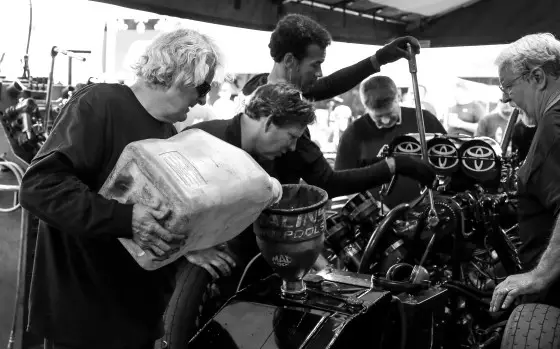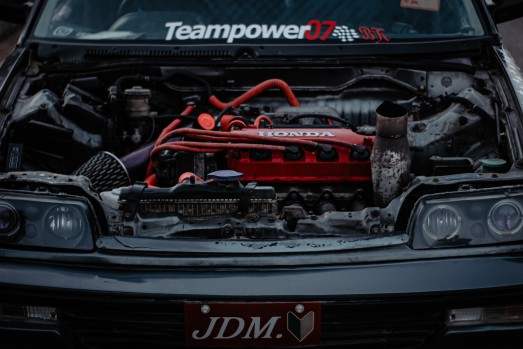The engine’s fluid balance and purity are critical components in the complex machinery that drives our cars, guaranteeing efficient and seamless functioning. Coolant and engine oil are two of these vital fluids, each with a specific function in preserving the engine’s peak performance. However, the regrettable and frequent error of inadvertently combining coolant with motor oil can break this delicate equilibrium. This mistake might have disastrous effects, seriously harming the engine and, as a result, the vehicle’s overall performance.
Importance of addressing the issue promptly to prevent damage to the engine:
It is crucial to take quick action when coolant and engine oil accidentally combine to avoid causing the engine irreversible harm. The exact lubrication offered by engine oil and the cooling action of coolant are critical to the engine’s operation. These fluids’ combined qualities, when polluted, can create a corrosive mixture that puts the engine’s internal parts in danger. The longer this polluted mixture runs through the engine, the higher the chance of considerable damage, such as increased bearing wear, crankshaft damage, and impaired piston performance.

How the Mistake Happens:
A. Lack of Awareness
- It is possible that many car owners are unaware of all the fluid systems in their cars.
- limited knowledge of the many reservoirs, covers, and colors that correspond to coolant and engine oil.
B. Similar Packaging:
- Containers for engine oil and coolant may have similar appearances, particularly for those who are unfamiliar with automotive goods.
- Confusion while refilling a container might be caused by unclear labeling or missing differentiating characteristics.
C. Multi-tasking or Distractions:
- Concurrently doing many maintenance operations increases the risk of errors, such as putting coolant into the incorrect reservoir.
- Distractions in the workshop or garage can deflect focus, which raises the risk of pouring the incorrect liquid.
D. Inadequate Lighting Conditions:
- It might be difficult to see the difference between the coolant and engine oil reservoirs in the engine compartment due to poor illumination.
- If the wrong fluid is supplied accidentally due to misidentification due to inadequate visibility, mixing may occur.
E. Rushed or Hasty Actions:
- People who are rushing through maintenance chores could forget to follow the right protocols and quickly pour fluids in the wrong places.
- Errors during normal maintenance might be attributed to impatience or a desire to save time.
F. Incomplete Understanding of the Vehicle:
- Confusion about the positions of the coolant and engine oil compartments may arise from ignorance of the car’s make and model.
- Unintentional errors may occur if the owner’s handbook is not consulted.
Immediate Signs of Coolant Contamination:
A. Milky or Foamy Appearance of Engine Oil:
- A milky or frothy consistency in the engine oil on the dipstick may be visible upon visual inspection.
- Coolant and oil emulsify and exhibit a noticeable color and texture change that suggests contamination.
B. Overheating Issues:
- Temperature regulation of the engine may be hampered by coolant pollution.
- While operating the car, drivers may observe irregular temperature gauge readings or persistent overheating.
C. Loss of Coolant Without Visible Leaks:
- Coolant level drop may result from coolant interacting with engine oil.
- There could be no obvious leaks despite the coolant loss, which might confuse the owner of the car.
D. Unusual Exhaust Smoke (White Smoke):
- Exhaust smoke that is white or light grey in color may come from the engine’s coolant combustion.
- The obvious sign that coolant is entering the combustion chamber and burning with the fuel is white smoke.
E. Foaming in the Coolant Reservoir:
- Inspection of the coolant reservoir may reveal foaming or bubbling, indicating a chemical reaction between the coolant and engine oil.
- The presence of foam in the coolant reservoir suggests cross-contamination between the two fluids.

Consequences of Coolant in Engine Oil:
A. Loss of Lubrication Properties:
- Lubricating engine oil helps to lower friction between moving elements.
- The lubricating properties of oil are compromised by coolant pollution, which increases engine component wear and tear.
B. Formation of Sludge:
- It is possible for sludge to develop when engine oil and coolant are combined.
- The accumulation of sludge can block oil passageways, making it harder for the oil to move freely throughout the engine.
C. Corrosion of Engine Components:
- Additives in coolant help shield the cooling system from corrosion.
- Coolant accelerates wear and damage to internal engine components by introducing corrosive substances when it combines with engine oil.
D. Reduced Heat Dissipation:
- When it comes to dispersing the heat produced during combustion, engine oil is essential.
- Operating temperatures are raised when coolant contamination reduces the oil’s capacity to dissipate heat.
E. Degradation of Oil Viscosity:
- Engine oil viscosity may change because of coolant dilution.
- Lubrication is further compromised by reduced viscosity since it makes it harder for the oil to maintain the appropriate film thickness between moving components.
F. Damaged Bearings and Journals:
- Journals and bearings may experience excessive wear due to improper lubrication.
- This wear can cause permanent damage over time, requiring costly repairs or an engine replacement.
H. Increased Friction and Heat:
- The reduced lubrication characteristics might result in higher friction between engine components.
- Increased heat from elevated friction feeds a vicious cycle that further damages interior components.
Steps to Take When Coolant is Mixed with Engine Oil:
A. Cease Engine Operation Immediately
- To stop more harm, turn off the engine.
- Never try to operate the car while the fluids are tainted.
B. Identify the Source of Contamination
- Examine the engine area visually to determine the cause of the coolant leak.
- Check the cooling system for any evident signs of damage to the radiator, hoses, or other components.
C. Drain Contaminated Fluids
- To get rid of the contaminated oil, empty the engine’s oil pan.
- Remove the radiator drain plug to remove the contaminated coolant.
D. Inspect the Cooling System and Engine Components
- Examine the radiator, hoses, and other cooling system parts for leaks or damage.
- Look for signs of corrosion or coolant contamination on the engine components.
E. Replace the Oil Filter
- Install a new oil filter to ensure that any coolant residue is removed from the oil system.
- Choose an excellent oil filter that satisfies the vehicle’s needs.
F. Flush the Engine
- Use a flushing chemical recommended by the car manufacturer to clean the engine internals.
- Use the flushing process outlined in the owner’s manual to remove any remaining contaminants.
G. Refill with Fresh Fluids
- Use fresh motor oil that is suggested by the manufacturer to fill the engine.
- Refill the cooling system with the appropriate coolant, making sure that the ratio of coolant to water is correct.
H. Start the Engine and Monitor
- After starting it, give the engine some time to run.
- Keep an eye on the engine’s fluid levels and temperature as you search for leaks.
I. Perform a Compression Test
- Perform a compression test to assess the integrity of the internal engine components.
- Seek out any compression anomalies that could indicate considerable damage.
K. Document the Incident
- Keep records of the incident, including images and a detailed narrative.
- Documentation may be useful for filing insurance claims or communicating with mechanics.
L. Monitor the Vehicle
- Observe the car’s performance closely in the days following the incident.
- Keep a watch out for any unusual symptoms or clues that suggest unresolved issues.

Flushing and Replacing Fluids:
A. Understand the Importance of Flushing
- Recognize that maintaining the integrity of the engine and eliminating contaminants need cleaning.
- Realize that a thorough flush is necessary to prevent any residual coolant from doing more damage.
B. Choose the Right Flushing Agent
- Choose the flushing agent that the car manufacturer recommends.
- Make sure the cooling system and engine can handle the cleansing agent.
C. Gather Necessary Tools and Materials
- Get the necessary equipment, such as a drain pan, a flushing agent, and the proper wrenches.
- Make sure you have the appropriate amount of brand-new coolant and engine oil on hand for the flushing procedure.
D. Prepare the Engine
- Before beginning the flushing procedure, let the engine cool.
- To collect the draining fluids, place the drain pan underneath the oil pan.
E. Drain the Engine Oil
- To empty the tainted engine oil, remove the drain plug.
- To ensure that as much tainted oil is removed as possible, let the oil drain entirely.
F. Add the Flushing Agent
- To get the right amount, refer to the flushing agent’s packing directions.
- Using the oil filler cap, introduce the flushing chemical into the engine.
G. Run the Engine
- For the time indicated by the flushing agent instructions, start the engine and let it idle.
- To move the flushing agent throughout the engine, sometimes use the throttle.
H. Drain the Flushing Agent
- Once the specified flushing time has passed, turn off the engine.
- Take off the oil drain plug to empty the flushing agent.
I. Change the Oil Filter
- Put in a brand-new, premium oil filter.
- Make sure that the flushing agent and new engine oil are compatible with the oil filter.
J. Refill with Fresh Engine Oil
- Fill the engine with the required amount and new engine oil.
- To avoid spillage and overfilling, use a funnel.
K. Flush the Cooling System
- Refer to the manufacturer’s instructions for cooling system cleansing.
- If a radiator flush solution is advised, use it to make sure any leftover coolant is completely removed.
L. Refill the Cooling System
- Fill the cooling system with the recommended amount of coolant.
- As directed by the manufacturer, mix the coolant with water.
M. Run the Engine and Check for Leaks
- Turn on the engine and keep an eye out for any anomalies or leaks.
- Verify that the cooling system is running correctly and that the engine achieves its usual operating temperature.
Frequently asked questions:
What occurs if coolant is inadvertently mixed with oil?
In an engine, combining coolant and oil can cause overheating, damaged lubrication, and other problems.
How should one proceed if coolant gets into the oil?
If coolant and oil combine, the engine should be stopped right away. The coolant leak should be fixed, tainted fluids drained, and new coolant and oil added.
What occurs if coolant enters the engine?
To prevent serious engine problems, coolant entering the engine must be stopped right once. Coolant entering the engine reduces lubrication, causes overheating, and may cause damage.
Can engine oil get contaminated by coolant?
Indeed, coolant may contaminate engine oil, which can result in poor lubrication, overheating, and even damage to engine parts.
Conclusion:
The dangerous situation of unintentionally combining coolant and motor oil necessitates prompt attention and prompt action. Such pollution can have serious negative effects on the engine’s essential parts, necessitating expensive repairs or even engine failure. Recognizing the indicators of coolant contamination, such as a milky look of the oil, overheating, or peculiar exhaust smoke, is vital for initial action.

